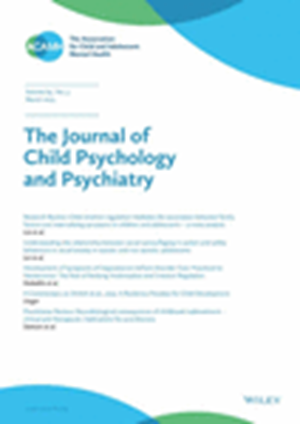The longitudinal role of sleep on self-harm during adolescence: A birth cohort study.
IF 7
1区 医学
Q1 PSYCHIATRY
引用次数: 0
Abstract
BACKGROUND Sleep problems and self-harm during adolescence are both highly common and major public health concerns, yet the nature of their relationship remains poorly understood. This study examined the cross-sectional and long-term effects of several sleep phenotypes on self-harm and whether decision-making moderated this relationship. METHODS Data was utilised from the Millennium Cohort Study (n = 10,477, Female = 5,314 [50.72%]) when individuals were approximately 9 months, 14 years and 17 years of age. Sleep variables available were measured at 14 years and included sleep duration on weekdays and weekends, social jetlag, sleep onset latency and night awakenings. Self-harm was measured at 14 and 17 years. The Cambridge Gambling Task assessed rational decision-making at 14 years. RESULTS Cross-sectionally, shorter sleep duration on school days (AOR = 0.875; 95% CI = 0.820, 0.933; p < .001), longer sleep onset latency (AOR = 1.005; 95% CI = 1.002, 1.007; p < .001) and more frequent night awakenings (AOR = 1.140; 95% CI = 1.086, 1.197; p < .001) were significantly associated with self-harm at 14, even when controlling for demographic and clinical covariates. Longitudinal results indicated that shorter sleep duration on school days (AOR = 0.926; 95% CI = 0.874-0.982; p = .010), longer sleep onset latency (AOR = 1.003; 95% CI = 1.001-1.005; p = .008) and more frequent night awakenings (AOR = 1.090; 95% CI = 1.043-1.139; p < .001) also had a direct prospective effect on self-harm at 17 when controlling for demographic and clinical factors. Rational decision-making as measured by the Cambridge Gambling Task did not significantly contribute to this relationship. CONCLUSIONS These findings highlight the prospective association between short sleep duration, increased sleep onset latency, fragmented sleep and self-harm during adolescence. Ensuring adolescents obtain enough good quality, uninterrupted sleep appears critical to prevent engagement with self-harm.青少年时期睡眠对自我伤害的纵向作用:一项出生队列研究。
背景:青少年时期的睡眠问题和自我伤害都是非常普遍的,也是主要的公共健康问题,但它们之间关系的本质仍然知之甚少。这项研究考察了几种睡眠表型对自我伤害的横截面和长期影响,以及决策是否会调节这种关系。方法数据来自千禧年队列研究(n = 10,477,女性= 5,314[50.72%]),受试者年龄分别为9个月、14岁和17岁。研究人员测量了14年的睡眠变量,包括工作日和周末的睡眠时间、社交时差、睡眠开始潜伏期和夜间醒来。在14岁和17岁时测量自残。剑桥赌博任务评估了14岁时的理性决策。结果横截面上,学生在校期间睡眠时间较短(AOR = 0.875;95% ci = 0.820, 0.933;p < 0.001),较长的睡眠开始潜伏期(AOR = 1.005;95% ci = 1.002, 1.007;p < .001)和更频繁的夜间醒来(AOR = 1.140;95% ci = 1.086, 1.197;P < 0.001)与14岁时的自我伤害显著相关,即使在控制人口统计学和临床协变量时也是如此。纵向结果显示,在校期间睡眠时间较短(AOR = 0.926;95% ci = 0.874-0.982;p = 0.010),较长的睡眠开始潜伏期(AOR = 1.003;95% ci = 1.001-1.005;p = 0.008),夜间醒来次数较多(AOR = 1.090;95% ci = 1.043-1.139;P < 0.001)在控制人口统计学和临床因素后,对17岁的自我伤害也有直接的前瞻性影响。通过剑桥赌博任务衡量的理性决策对这种关系没有显著贡献。结论这些发现强调了青少年睡眠时间短、睡眠发作潜伏期增加、睡眠碎片化与自我伤害之间的潜在关联。确保青少年获得足够高质量、不间断的睡眠对于防止自残行为至关重要。
本文章由计算机程序翻译,如有差异,请以英文原文为准。
求助全文
约1分钟内获得全文
求助全文
来源期刊
CiteScore
13.80
自引率
5.30%
发文量
169
审稿时长
1 months
期刊介绍:
The Journal of Child Psychology and Psychiatry (JCPP) is a highly regarded international publication that focuses on the fields of child and adolescent psychology and psychiatry. It is recognized for publishing top-tier, clinically relevant research across various disciplines related to these areas. JCPP has a broad global readership and covers a diverse range of topics, including:
Epidemiology: Studies on the prevalence and distribution of mental health issues in children and adolescents.
Diagnosis: Research on the identification and classification of childhood disorders.
Treatments: Psychotherapeutic and psychopharmacological interventions for child and adolescent mental health.
Behavior and Cognition: Studies on the behavioral and cognitive aspects of childhood disorders.
Neuroscience and Neurobiology: Research on the neural and biological underpinnings of child mental health.
Genetics: Genetic factors contributing to the development of childhood disorders.
JCPP serves as a platform for integrating empirical research, clinical studies, and high-quality reviews from diverse perspectives, theoretical viewpoints, and disciplines. This interdisciplinary approach is a key feature of the journal, as it fosters a comprehensive understanding of child and adolescent mental health.
The Journal of Child Psychology and Psychiatry is published 12 times a year and is affiliated with the Association for Child and Adolescent Mental Health (ACAMH), which supports the journal's mission to advance knowledge and practice in the field of child and adolescent mental health.

 求助内容:
求助内容: 应助结果提醒方式:
应助结果提醒方式:


